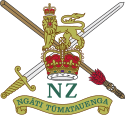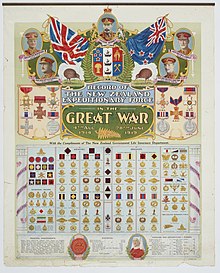New Zealand Expeditionary Force
 |
| New Zealand Army New Zealand Defence Force |
|---|
| Components |
| Administration |
| Regiments |
| Corps |
|
| Equipment |
| New Zealand portal |
The New Zealand Expeditionary Force (NZEF) was the title of the
The 2NZEF was led by General Bernard Freyberg.
1st New Zealand Expeditionary Force
This section needs additional citations for verification. (February 2012) |
The New Zealand Expeditionary Force (NZEF) was the title of the military forces sent from New Zealand to fight for Britain during World War I. Upon the outbreak of war, New Zealand immediately offered to provide two brigades—one of infantry and one of mounted troops—with a total of 8,500 men. As was the case with the Australian army the existing New Zealand army was a "territorial" force, designed for the defense of the home islands. It could not be deployed overseas. Hence, it was necessary to form a volunteer "expeditionary" force. The initial contingent of the NZEF, known as the "Main Body," sailed on 16 October 1914 for Australia and then joined with the Australian Imperial Force (AIF) in a convoy that sailed for Egypt on 1 November. The NZEF and AIF convoy was originally bound for Britain but diverted en route to Egypt because of the state of the training camps in England. As a result, the troops were dressed in woolen uniforms for the British climate. On 2 December the convoy reached Alexandria after passing through the Suez Canal. Disembarking the troops traveled by train for Cairo, bivouacking in tent camps within sight of the Pyramids.
The NZEF was commanded throughout the war by
Major General
New Zealand, like Australia, had a pre-war policy of compulsory military training, but, like Australia, New Zealand's Territorial Army could not be deployed overseas. Thus, the NZEF was initially composed solely of volunteers. Conscription was introduced on 1 August 1916 and by the end of the war 124,000 men—nearly half the eligible male population of 250,000—had served with the NZEF. Of these, about 100,000 had been sent overseas.
The NZEF was closely tied to the AIF for much of the war. When the
After the end of the Gallipoli campaign, the NZEF formed its own infantry division, the
The mounted arm of the NZEF was the
The New Zealand Expeditionary Force (later called the 1st NZEF) was finally disbanded on 31 December 1921.
Structure

New Zealand Expeditionary Force Order of Battle - 16 October 1914
- New Zealand Infantry Brigade
- 15th (North Auckland), and 16th (Waikato)Territorial Regiments
- Wellington Battalion: 4 Cos. raised from 7th (Wellington West Coast), 9th (Hawke's Bay), 11th (Taranaki), and 17th (Ruahine) Territorial Regiments
- Canterbury Battalion: 4 Cos. raised from 1st (Canterbury), 2nd (South Canterbury), 12th (Nelson), and 13th (North Canterbury and Westland) Territorial Regiments
- Otago Battalion: 4 Cos. raised from 4th (Otago), 8th (Southland), 10th (North Otago), and 14th (South Otago) Territorial Regiments
- 1st New Zealand Infantry Brigade Signal Co. (3 Sections)
- New Zealand Field Ambulance No. 1
- New Zealand Mounted Rifles Brigade
- Auckland Mounted Rifles: 3 raised from these territorial regiments: 4th (Waikato) Mounted Rifles, and 11th (North Auckland) Mounted Rifles
- Canterbury Mounted Rifles: 3 squadrons raised from these territorial regiments: 1st Mounted Rifles (Canterbury Yeomanry Cavalry), 8th (South Canterbury) Mounted Rifles, and 10th (Nelson) Mounted Rifles
- Wellington Mounted Rifles: 3 squadrons raised from these territorial regiments: 2nd (Wellington West Coast) Mounted Rifles, 6th (Manawatu) Mounted Rifles, 9th (Wellington East Coast) Mounted Rifles
- New Zealand Engineers Field Troop
- New Zealand Mounted Signal Troop
- New Zealand Mounted Rifles Field Ambulance
- Auckland Mounted Rifles: 3 raised from these territorial regiments:
- Divisional cavalry
- Otago Mounted Rifles: 3 squadrons raised from these territorial regiments: 5th (Otago Hussars), 7th (Southland), 12th (Otago)
- New Zealand Field Artillery Brigade
- 1st Field Battery
- 2nd Field Battery
- 3rd Field Battery
- 1st Brigade Ammunition Column
2nd New Zealand Expeditionary Force
Formation
At the outbreak of
Service in Africa and Europe
The first echelon of 2NZEF Headquarters and a Brigade Group landed in Egypt in February 1940. The second echelon, also a Brigade Group, was diverted to Britain on Italy's entry into the war and did not reach Egypt until March 1941. The third echelon arrived in Egypt in September 1940 and concentration of the division was completed just before it was
This force remained as part of the
Under the command of Major-General William Stevens, the 2NZEF began demobilising in late 1945, a process that was largely completed by mid-1946. Lt. Gen John C. H. Lee, Deputy Theater Commander of the Mediterranean Theater at this time, noted in his diary attending the termination ceremony of the New Zealand Force at Caserta, Italy on 3 September 1946.
Service in the Pacific
The 2NZEF also had a Pacific Section, which was initially responsible for the defence of
The Pacific Section later became the 3rd Division, the main unit of the 2NZEF in the Pacific.[10] After of period of training in New Zealand, it fought in the Solomon Islands campaign during 1943–1944, participating in the Battles of Vella Lavella, the Treasury Islands and the Green Islands,[11] although never as a full division.
In early 1944, the New Zealand Government faced a manpower crisis caused by the demands of maintaining two divisions overseas while simultaneously maintaining agricultural and industrial production to meet the needs of the Allied countries. In order to cope with this crisis the New Zealand Government saw no option other than to disband one of the country's two infantry divisions. The decision to disband the 3rd Division was made after consulting with the British and United States Governments, who were of the view that the 2nd Division's contribution to the campaign in Italy was of greater importance than the 3rd Division's contribution in the Pacific.[12]
The 3rd Division was withdrawn to New Caledonia in June 1944 and returned to New Zealand in August. The Division was rapidly downsized and was formally disbanded on 20 October 1944. About 4,000 veterans of the 3rd NZ Division were dispatched to Italy to reinforce the 2nd Division with the remaining men of the division returning to civilian employment.[13]
3rd New Zealand Expeditionary Force
From 1950 onwards a division-sized force, reserves (Territorial Force) maintained by conscription, formed the principal striking force of the New Zealand Army. The division was alternatively known as 3NZEF.[14] It disbanded in 1961.
See also
- Military history of New Zealand in World War I
- Māori Battalion
- New Zealand Forces Club
- New Zealand Tunnelling Company
- Buttes New British Cemetery (New Zealand) Memorial
Notes
- ^ Phillip. "Alfred William Robin". Dictionary of New Zealand Biography. Ministry for Culture and Heritage. Retrieved 23 April 2017.
- ^ Pugsley 2014, p. 15.
- ^ Pugsley 2014, p. 16.
- ^ Pugsley 2014, p. 19.
- ^ Pugsley 2014, p. 25.
- ^ 2 Div NZFE Archived 29 May 2010 at the Wayback Machine DiggerHistory.Info Inc
- ^ Gillespie, 1952, p. 26
- ^ Gillespie, 1952, p. 45
- ^ Gillespie, 1952, pp. 55–56
- ^ Gillespie, 1952, p. 56
- ^ Gillespie, 1952, p. 194
- ^ Gillespie, 1952, pp. 195–198
- ^ Gillespie, 1952, pp. 201–203
- ^ Damien Marc Fenton, 'A False Sense of Security,' Centre for Strategic Studies: New Zealand, 1998, p.12
References
- Gillespie, Oliver A. (1952). The Pacific. Official History of New Zealand in the Second World War 1939–1945. Wellington, New Zealand: War History Branch. OCLC 59000607. Retrieved 13 January 2015.
- ISBN 978-0-143-57189-6.
Further reading
- Books
- Mackay, Don (2012). The Troopers Tale:The History of the Otago Mounted Rifles. Dunedin: Turnbull Ross. ISBN 978-0-473-20462-4.
- ISBN 978-1-84342-408-6. Retrieved 13 January 2015.
- Websites
- Nan Kivell, Rex. "Rex Nan Kivell Collection of Negatives ca. 1917–1919". Canberra, ACT: Pictures Collection National Library of Australia. Retrieved 13 January 2015.
- "New Zealand and the First World War: Overview". New Zealand's History Online. Retrieved 26 January 2007.
- "The First World War". NZ History. Retrieved 13 January 2015.
- "New Zealand ANZACS in the Great War 1914–1918". UNSW Canberra. Retrieved 11 May 2015.

